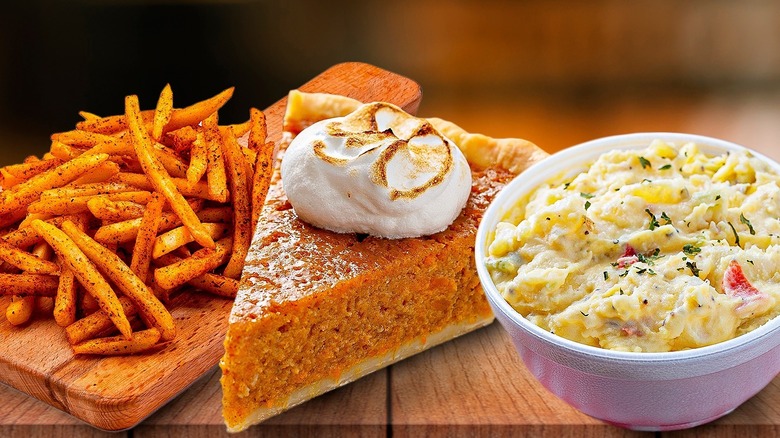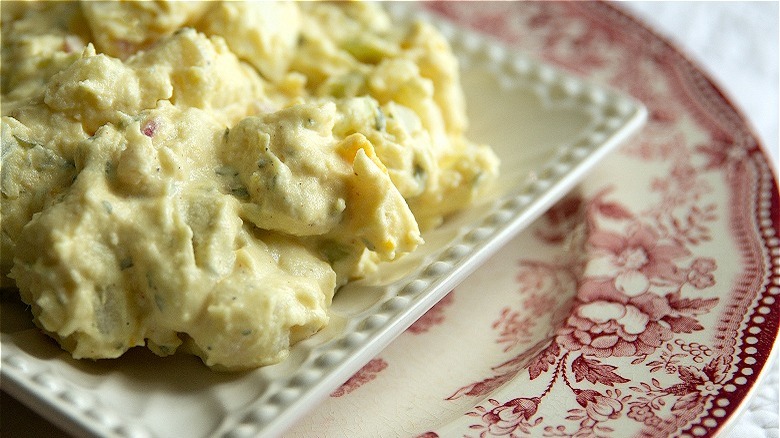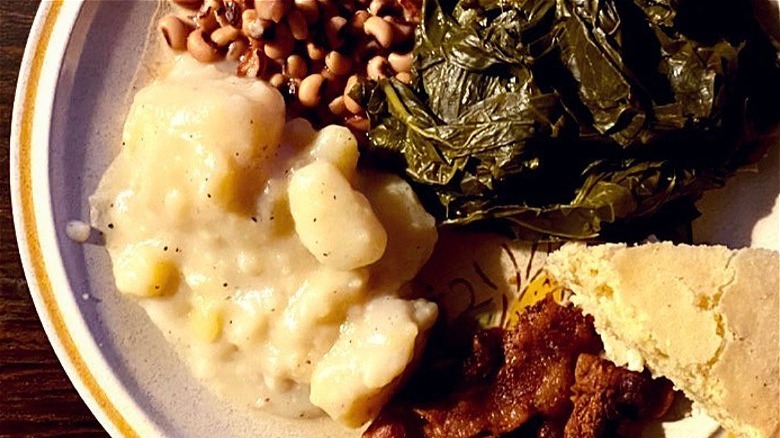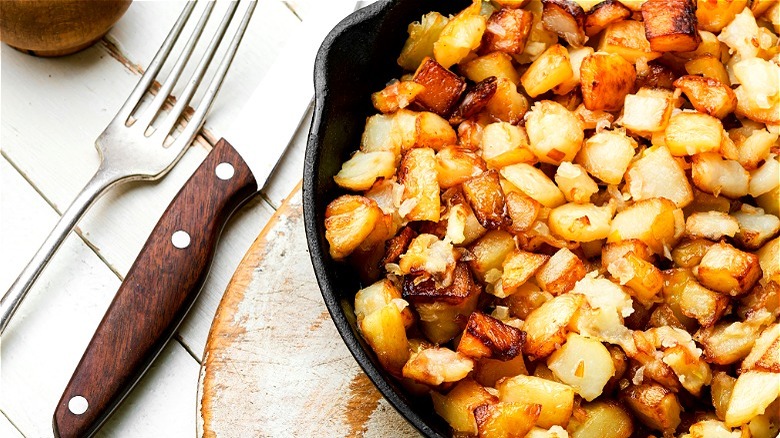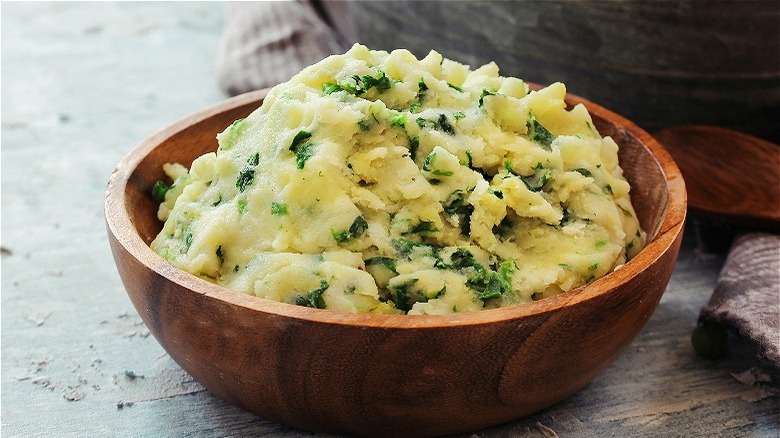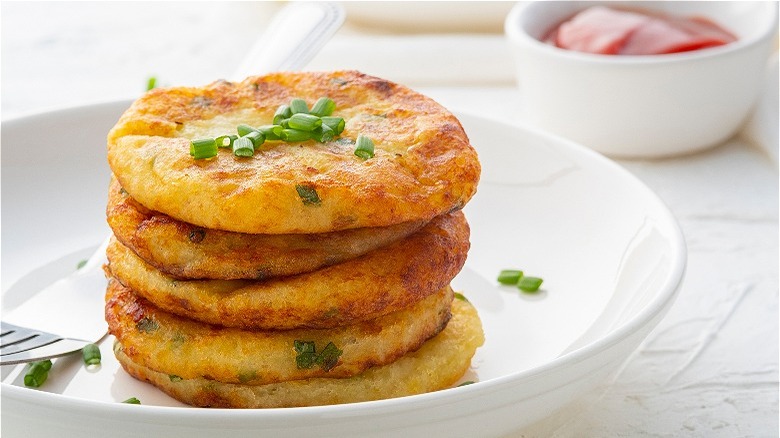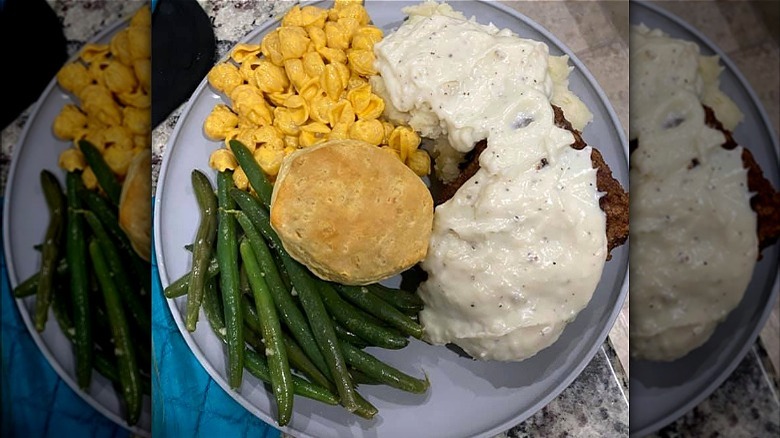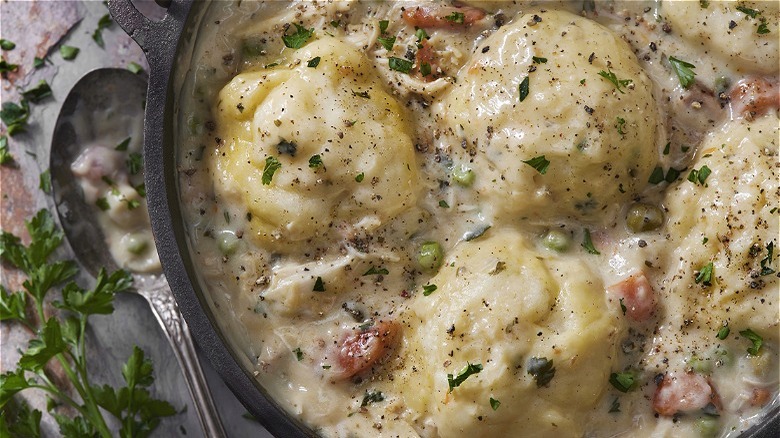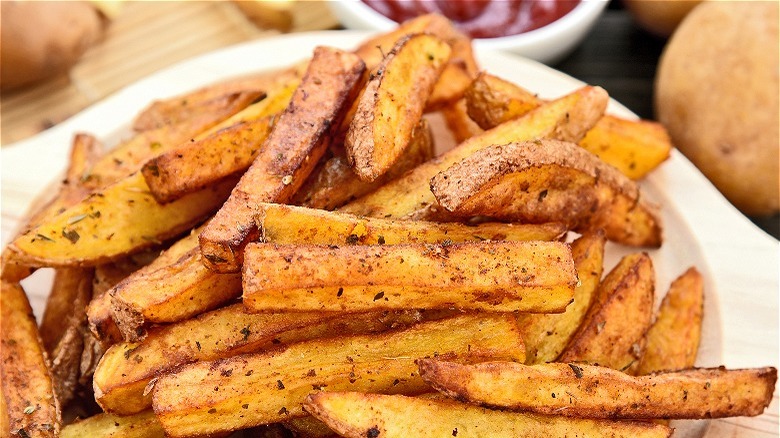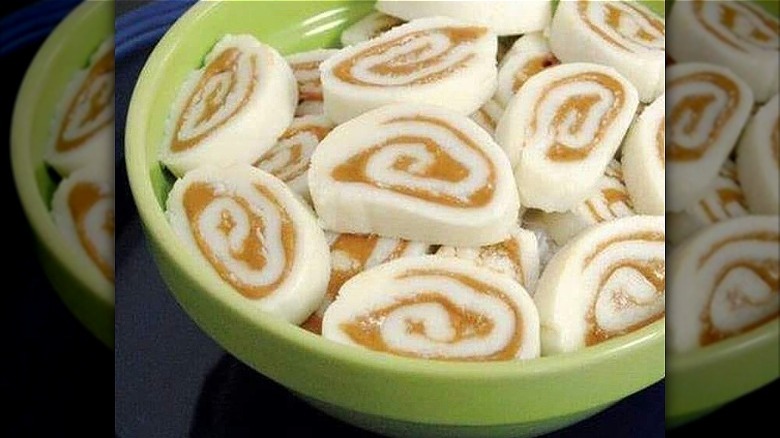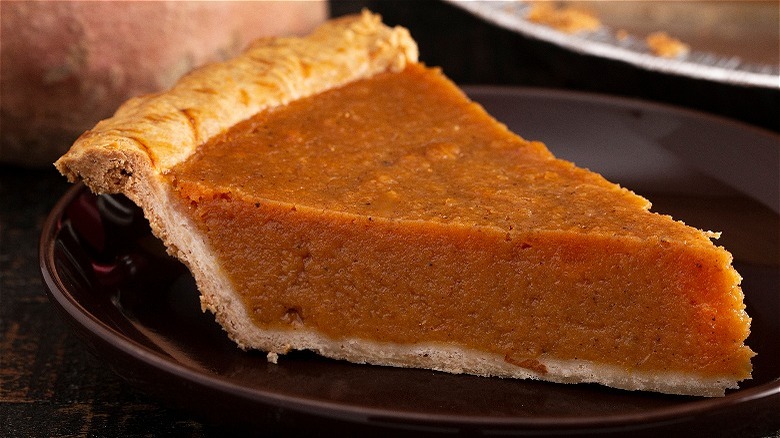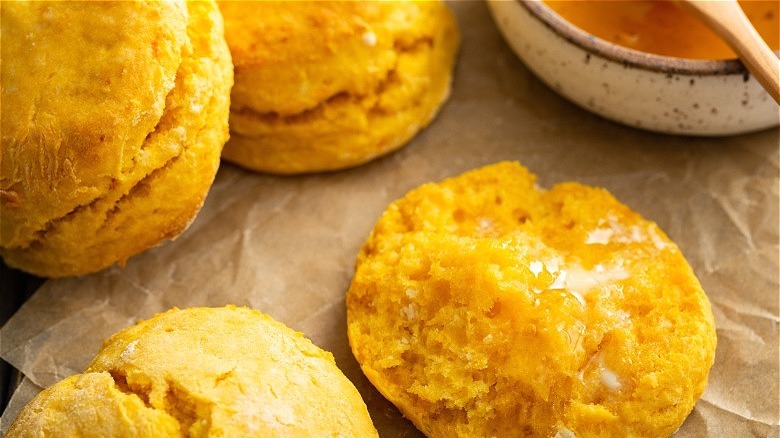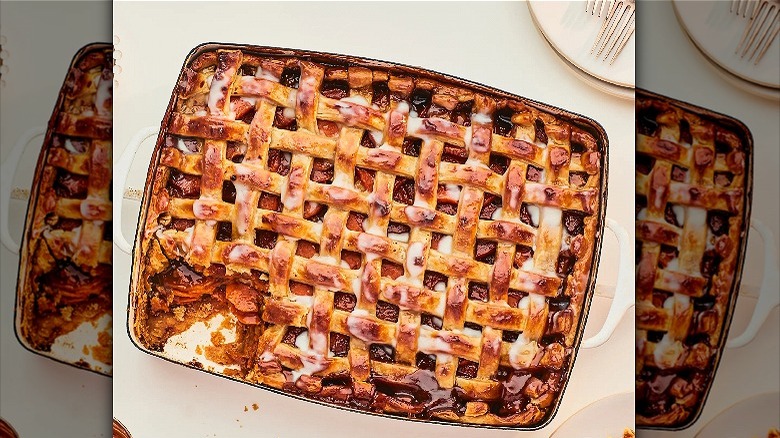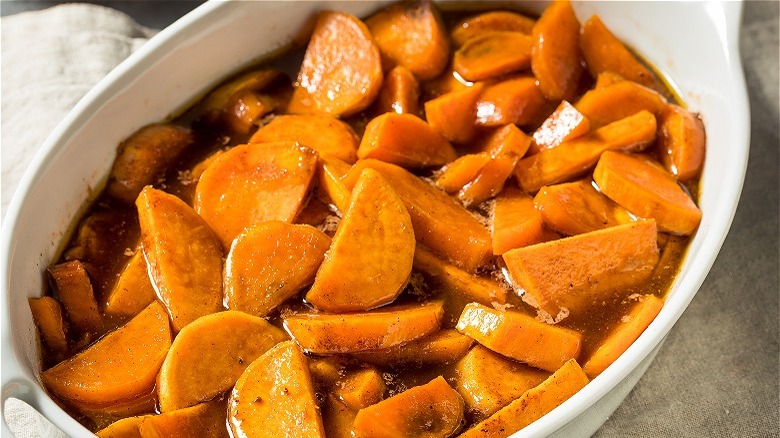13 Southern Potato Dishes You Should Know About
Potatoes are as ubiquitous on Southern tables as fried chicken and sweet tea, but they haven't always been a part of the food culture in the American South. Only two types of wild potato are native to the U.S., and the tiny tubers bear little resemblance to the big, fleshy bakers you're probably used to. The varieties we know best have South American roots and were first brought to Europe by the Spanish. Potatoes also came to the American colonies via the Irish.
Cultural and culinary traditions vary from state to state and even regionally, which is why potato dishes in Texas will be quite different from those found in Louisiana. Tennessee and North Carolina may share a border, but you still won't find many Tennesseans making "sonker." The various potato dishes of the South reflect the diversity and history of the people who live there, but since you can't taste history, try these Southern-style dishes simply because they're darn good.
Southern potato salad
Everyone seems to have their own way of making potato salad, and the version you like best is probably the one you ate when you were growing up. Some prefer the vinaigrette-tossed German potato salad, served while it's still warm. Others may like a more modern version that riffs on the baked potato with cheese, bacon, and chives in a sour cream dressing. For Southerners, the classic potato salad of a million BBQs, potlucks, and church suppers is perfectly chilled and creamy with a sunny yellow color beckoning from the bowl.
Made correctly, Southern potato salad is the first thing that will run out at a picnic buffet. If it's made incorrectly, the maker will never be invited to bring the potato salad again and will likely be placed on napkin and paper plate duty. While every family has its own special tweaks, the basic ingredients are potatoes, hard-boiled eggs, pickle relish, mayo, salt and pepper, and a bit of mustard. Common additions are onions, celery, celery salt, and apple cider vinegar, but expect disagreement from clan to clan. Feuds have arisen over the brand of mayo — Hellman's, Duke's, and Blue Plate all have their own warring factions — and some folks will run you out of town if you don't put paprika on the top.
Stewed potatoes
Stewed potatoes are the sort of food that lets you know you're really in the South, as they're not easy to find in other parts of the country. In fact, they're getting tricky to find even at Southern restaurants, though you can still spot them in the wild on a few menus in Tennessee and Georgia. Stewed potatoes are true home-cooked food, so they're mostly found at home, simmering in a big pot on the stove. Similar to how Appalachian pinto beans are known as "soup beans," stewed potatoes are sometimes called "soup taters," though they're not a soup. You can also find folks who call them "sloppy taters" or "gravy potatoes."
The important factor in stewed potatoes is that they're not drained, and after slow simmering with butter or bacon grease (and a lot of salt and pepper), the starchy water begins to thicken, making a surprisingly thick "gravy," even without milk. Some cooks do add a bit of water and flour to make more of a roux, but it's not essential. It's a dish that was born out of lean times, stretching simple ingredients into a meal. Though most commonly served plain, some families may add peas, onions, sausage, or even dumplings — the latter a way of making a dish as filling as chicken and dumplings when there's no chicken around.
Southern fried potatoes
From Spanish patatas bravas to South African slap chips, nearly every country has discovered its own way of frying potatoes in oil for a hot, crispy treat. In the U.S., pan-fried potatoes are plenty popular under a variety of guises: hash browns, home fries, and potatoes O'Brien, to name a few.
So, what makes Southern fried potatoes any different? For starters, no true Southerner would cook them in anything but a cast iron skillet, which cooks the potatoes to crispy perfection. These days, heart-healthy olive or canola might be the oil of choice, but truly old-fashioned fried potatoes are best with bacon grease. If you don't keep bacon grease on hand, fry up some bacon, then turn down the heat and cook your potatoes (with plenty of onions) in the remaining grease. The still-hot skillet should be just right for frying potatoes.
Cook until the edges and bottom are crispy and dark. Plenty of people savor the crunchy, almost-burnt pieces as the best part. Add peppers, garlic, or crumbled bacon if you like — there's no rule against it. Fried potatoes are a welcome addition to a big Southern breakfast with fried eggs, country ham, and biscuits and gravy, but they're every bit as good at suppertime.
Mashed potatoes with greens
Quite a few of the oldest Appalachian recipes reflect the influence of the Irish, and for good reason. Between 1820 and 1930, millions of Irish people came to the United States, and quite a few of them settled in the Appalachian Mountains (North Carolina still today is the leading state in the number of people with Scots-Irish ancestry). They didn't just bring potatoes with them, but also their ways of cooking. The traditional Irish dish of colcannon is made with potatoes mashed with milk and butter and cooked with cabbage or kale. It carried over well to the region, with greens growing in such abundance.
Though they may not call it by its Irish name, plenty of Southerners continue to enjoy greens and potatoes together, not just with cabbage or kale, but with turnip, mustard, or collard greens. When they're in season in the South, ramps or spring onions are a worthy addition to potatoes and greens. An oft-seen variation is made with cubed potatoes rather than mashed, making a dish more akin to a hash. You can see the influence of this dish in the potatoes and green beans Southerners often cook in one pot and serve mixed together.
Southern potato cakes
Potato cakes are another traditional Southern dish with an obvious connection to the European immigrants that settled in the Appalachian mountains. The resemblance to Irish boxty is noticeable and, in some parts of the Appalachian South, people still refer to them as arsh potato cakes ("arsh" being a rendering of "Irish" in a Southern accent). Others call them potato patties, potato fritters, or tater cakes. Unlike Jewish latkes or other grated potato cakes, Southern-style potato cakes are made from mashed potatoes, so they're often cooked as a way to use up leftovers.
Potato cakes, like a lot of recipes with Appalachian roots, are a meal that's easy to make when there's not a lot in the cupboard. All you need besides the potatoes are an egg, seasonings, and perhaps a chopped onion, if you have one. They can be dressed up, of course, and popular additions are fresh corn, peppers, and chopped green onions. Kale or other greens are another common addition, making a dish that bears a resemblance to the British bubble and squeak. Though traditionally eaten during lean times, they're just as good when you have plenty as a side for meatloaf or pork chops.
Mashed potatoes with white gravy
Brown gravy may be the default mashed potato topping in a lot of parts of the country, and it's certainly the go-to ingredient for frozen dinners, roadside diners, and Thanksgiving tables. For most Southerners, though, the default gravy is always going to be white. The rich, peppery taste of white gravy elevates mashed potatoes to creamy perfection. Though it's known by different names — including white gravy, country gravy, sawmill gravy, and peppered gravy — many in the South simply call it "gravy." Other gravies, like brown gravy or redeye gravy, are the ones that need further description.
Because brown gravy is beef-based, it wasn't common on Southern Appalachian tables, where pork reigned supreme. On a budget, white gravy can be made with butter instead of grease, but the most flavorful country gravies begin with bacon or sausage drippings. Mashed potatoes are a quintessential side dish on country dinner plates and the beauty of serving them with white gravy is that the gravy works with almost everything else on the table. If you're serving a Southern-style meal, you can ladle white gravy over your fried chicken or chicken-fried steak, then ladle some over your biscuits, before you even get to the mashed potatoes. If you're below the Mason-Dixon line, no one will bat an eyelash if you gravy up the whole plate.
Potato dumplings
Not every traditional Southern potato dish was influenced by Irish immigrants, of course. In 1900, Germans made up the largest group of foreign-born members of the population in nearly every Appalachian state. German food customs came to the area along with the people, which is why you'll still find plenty of Southerners canning homemade apple butter or sauerkraut from recipes that have been handed down for generations. Potato dumplings are another dish that came to the area via German immigration and they still have a place on plenty of Southern tables.
The potato dumpling of the South typically integrates potato into biscuit dough, and many recipes for the dumplings list "biscuit dough" as one of the ingredients. The resulting dumplings can be eaten alone, but are more frequently dropped into chicken soup or used in place of the flour dumplings in chicken and dumplings. Those who prefer the "slick" style of dumplings to the biscuit style sometimes fortify them with a bit of mashed potato or dried potato flakes before slipping them into their chicken and dumplings.
Cajun fries
In the '80s, partly as a result of Chef Paul Prudhomme's popularization of Louisiana cooking, the word "cajun" started appearing all over the place, often in places where it barely belonged. restaurants threw a bit of paprika onto a dish and rebranded it as Cajun. Cajun fries were one of the frequently-seen menu items that capitalized on the trend. You'll still find Cajun fries to this day that don't have anything at all to do with the cuisine of the Louisiana Bayou. That doesn't mean that all Cajun fries are imposters, though, and the dish genuinely does have Southern roots — if you make it right.
Local restaurants in Louisiana have advertised Cajun fries since at least the 1950s (and it's worth noting that fast food favorite Popeyes, which features Cajun fries, had its beginnings in Louisiana). True Cajun fries need more than just a hint of spice and are best seasoned with a blend of fiery cayenne pepper, paprika, garlic powder, and salt. If they're not hot, they're only pretending to be Cajun.
For next-level Cajun fries, you can add hot sauce to the water when you soak the potatoes, then serve with spicy ketchup or a homemade remoulade for decadent dipping.
Appalachian potato candy
A lot of Southern potato dishes were originally devised as ways to stretch out a lean pantry and make a filling meal using the hearty potato to feed a hungry family. Everyone deserves a treat sometimes, though, and the inventive Appalachians figured out a way to turn the potato into a sweet treat. Potato candy uses only three ingredients: potato, confectioner's sugar, and peanut butter. The resulting candy may sound peculiar, but anyone who tries it without knowing the secret ingredient can rarely guess it.
Rest assured, there's no hint of the potato in the taste. Rather, the potato acts as a binder to hold together all the sugar, resulting in a fluffy-textured confection. The thin swirl of peanut butter adds a nice contrast to what would otherwise be almost pure sugar, and it looks pretty, too. For many families in the South, Appalachian potato candy is still a holiday tradition and is given as a gift in decorated tins. Some like to tint it pink with food coloring, but it's more frequently found in its natural state of snowflake white.
Sweet potato pie
The cultural melting pot of the American South has led to some of the country's greatest dishes. The saying that "too many cooks spoil the broth" doesn't apply when it comes to culinary history, as it seems that the more cultures that contributed to the evolution of a dish, the better it is. A case in point: the sweet potato pie. We have Indigenous Americans to thank for cultivating the sweet potato in North America, and we have Black Americans to thank for putting them in a pie, adapting the European recipe for pumpkin pie to use ingredients more readily available in the South.
For lots of families, it's a must-have dish on Southern tables at Thanksgiving and Christmas. While some swear by pumpkin pie (and some families split the difference with one of each), plenty of folks proclaim sweet potato pie as the one and only pie worth having. The taste of a well-made sweet potato pie is something special, especially if the sweet potatoes are roasted before pureeing, allowing the sugars to deeply caramelize. The heady aroma as the pie bakes in its flaky shell is the smell of a Southern Christmas. Break out the whipped cream and all is well with the world.
Sweet potato biscuits
There's no denying that biscuits are important to southern cuisine, though most people think of the fluffy, mile-high biscuits that are made with buttermilk and soft flour, served with butter and your mamaw's peach preserves or — even better — a big ladle full of sausage gravy. You may not know that there's another kind of biscuit that finds its way onto Southern tables from time to time: the distant cousin of the buttermilk biscuit known as the sweet potato biscuit.
Sweet potato biscuits are not quite as airy as classic biscuits, but what they lack in texture they more than make up for with their flavor. They're not as sweet as a dessert, so don't expect a donut, but they're just sweet enough. You can increase the saccharine element, if you like, by topping hot biscuits with cinnamon butter or your favorite jam. Arguably the best use for sweet potato biscuits is to eat them with a slice of salty country ham. The contrast of the soft biscuit with the savory ham is a true southern delight. Can't decide? Try a sweet potato biscuit with chili-infused honey.
Sweet potato sonker
If you've never eaten a sonker, then it's obvious where you don't live. The dish is not just unique to North Carolina, but it's unique to a specific county in North Carolina. Unless you've lived in or visited Surry County, chances are slim that you've sampled the deep-dish dessert; okay, maybe folks in nearby Wilkes County enjoy a sonker now and again, but the tradition hasn't crept much further across the map. There's no doubt that locals are proud of it: The Surry County Historical Society hosts the annual Sonker Festival, where people gather for exhibits, music, and eat lots of sonkers.
So, what's a sonker? It's a lot like a juicy version of a cobbler or a pie, though usually made in a deeper dish and most commonly with a lattice top. Sonkers can have different fillings (especially fruits that thrive in the South, like blackberry and peach), but the sweet potato sonker is the one everybody talks about. The filling is not pureed like a pie filling but contains big chunks of juicy sweet potatoes. Another detail that separates the sonker from the cobbler is what's known as "milk dip," a sugary glaze that's slathered on top of the crust but also served alongside the dish for additional dipping or drizzling.
Candied yams
Candied yams can be confusing. Even sites that try to explain the difference between sweet potatoes and yams often get it wrong. Yes, sweet potatoes and yams are botanically very different vegetables, but what a lot of fact sheets seem to neglect is that in the U.S., sweet potatoes are colloquially referred to as yams.
A true West African yam is starchier than a white potato, difficult to find outside of specialty stores, and not something you'd use in a pie. The "yam" that is used in traditional Southern American dishes is a sweet potato. In fact, if you buy a can of yams, a close look at the label reveals that it is filled with sweet potatoes. Further complicating the issue is that the vegetable called a "garnet yam" is a variety of sweet potato.
By whatever name, candied yams have been a staple on many Southern tables since at least 1889 when the first recipe appeared in a cookbook. Black agricultural scientist George Washington Carver later published his own recipe for candied yams while he was studying sweet potatoes. When families today sit down to a holiday meal featuring a dish of perfectly-sweet yams, they're sharing in a tradition with deep, historical Southern roots. There may be arguments from family to family over whether to include bourbon, pecans, or even marshmallows, but once the dinner is plated, everyone is at peace.
